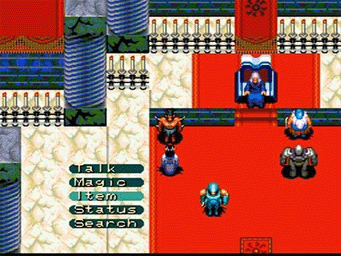For my first review here at GameCola, I decided to cover an old favorite of mine—The 7th Saga. This game has always held a certain place in my heart, and loading it up to help with the review brought along a certain bit of nostalgia.
Then, I remembered all of the reasons why I’ve only beaten it once.
Originally this was going to be a serious review, talking about the excellent graphics, amazing music, and whatever else it was that always compelled me to play this game. Only moments into starting a new game, however, I had already begun to recall the pain and torment so innocently named “The 7th Saga”.
Even looking at it ten years later, there are some unique ideas programmed into The 7th Saga. It’s an RPG, yet you never have true random encounters. At the beginning of the game, you’re given a crystal ball that allows you to view the locations of enemies, treasures, towns and the runes you’re supposed to be looking for. Sure, it’s just a bunch of dots with an overlaid bitmap of a circle, but it beats wandering around for an hour while constantly running into random battles as you’re trying to search for a town that doesn’t seem to exist.
The game also allows you to start as any of seven characters, allowing you to interact with the remaining six throughout the game. After the first segment of the story, you can convince another to come along with you as a second party member, but make sure that you save before talking to any of them. Based on the dynamics at play between the character archetypes, some will join willingly, and some will start fights.
Really, for the Super Nintendo, the graphics are awesome. The graphics during battle are fantastic, especially when you get into fights with the other apprentices. It shifts the camera to a view from behind your character, facing the enemies. I remember that I would often start a new game as another character just to see what my old one looked like from the front. If you’re on the world map, it actually uses the surrounding area as the backdrop, which was something I had never seen when the game first came out. Sure, there are a few map tiles in town that will cause your eyes to bleed, but the overall quality is pretty high.
The music is similarly sweet. There is a unique sound to it that I’ve always liked and I think is one of the things that made the game addictive to me. Like the graphics, there are a few songs that would make you scramble for the mute button, but these are luckily few and far between.
I know, I know—you’re wondering what could possibly be wrong with such a creative, well-designed game. Don’t worry, because I can sum up what’s wrong with the game in just one word:
Everything.
The game follows in many Enix traditions, such as “no real storyline,” “terrible inventory structure,” “losing half of your gold when you die,” “only allowing you to save over the file you chose when you started,” and going back to the good old NES days of “controlling world interaction through an incredibly stupid menu instead of just using the accept button like any good game should”.
Sure, they implemented jewels to help you store your money in something that can’t be stolen, but you can only hold nine of any item to begin with. On top of limiting how much gold you can safely have, this also means that you’re constantly going to be finding yourself missing out on dropped items (Most notably more jewels, if you went ahead and bought enough to actually keep it all safe).
And, yes, that’s right: Enix stopped just one step short of bringing back the “stairs” button by having you interact with the world through the slow, laborious process of navigating a menu to select your options every time you want to open a chest or talk to an NPC. Oh, and let’s not forget the joy of trying to buy or sell something when you’re kicked back to the main menu after selecting a single item.
Oh, and I feel I should correct my misleading statements from the beginning of this review. That crystal ball? It’s the most useless thing ever. It’s not a mini-map—it just shows you a bunch of wiggling dots in a circle. I would rather have random battles than constantly be chased around and taunted by stupid dots. It’s like the programmers wanted you to see your impending doom instead of allowing you the wonderful ignorance of not knowing when the next battle was coming. Sure, you can avoid battles for about three seconds; but, especially in a dungeon, you’re just going to end up further away from your destination if you try to run away. There is no escape.
Speaking of battles, good luck ever beating one of those apprentices. The normal fights you get into with them aren’t so bad, but there are a couple of points in the game where you’re required to fight them. And, get this—due to errors during localization, being properly leveled up can actually cause your story to come to a screeching halt. The first time you run into an apprentice, it’s better to be under-leveled so your enemy will do less than 90 damage and you can spam “Potn 2”s. If you get to that point and you’re over level 20, prepare to restart the game.
And, all of this is for what, again? Some runes or something? Wait, you mean there was actually a story in this game? Oh, I guess not, considering that you have about as much reason for moving to the next town as you did trying to find the Fairy Flute to make the Golem go to sleep. The game kicks into gear and goes crazy just around the time you thought it was going to end, but that’s only if you can manage to survive playing the game for that long.
For you gamers that enjoy that type of thing, though, there’s a lot of game to be played with this one. While the interaction with the world and the character’s own stories turned out to be disappointingly nonexistent, there are still a few little differences here and there. If you can stand the game to begin with, there’s quite a bit of replay value hidden in there.
So, overall, it’s a real tossup. If you want a hardcore game that will provide a good challenge, it can actually be pretty fun. There’s always been something about the game that’s kept me playing it, even if I’ve only beaten it once. However, if you like your games to “be fun,” “have a story,” or “not cause you to throw your controller at the TV,” you’re better off looking elsewhere. At least most Wii games have two out of three.


